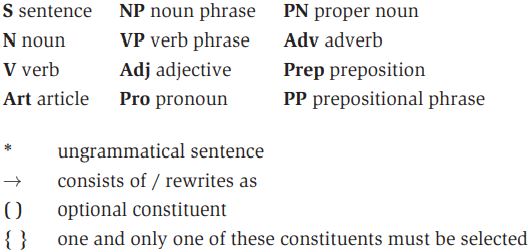


 Grammar
Grammar
 Tenses
Tenses
 Present
Present
 Past
Past
 Future
Future
 Parts Of Speech
Parts Of Speech
 Nouns
Nouns
 Verbs
Verbs
 Adverbs
Adverbs
 Adjectives
Adjectives
 Pronouns
Pronouns
 Pre Position
Pre Position
 Preposition by function
Preposition by function 
 Preposition by construction
Preposition by construction
 Conjunctions
Conjunctions
 Interjections
Interjections
 Grammar Rules
Grammar Rules
 Linguistics
Linguistics
 Semantics
Semantics
 Pragmatics
Pragmatics
 Reading Comprehension
Reading Comprehension|
Read More
Date: 2023-11-04
Date: 2023-11-14
Date: 7-2-2022
|
Symbols used in syntactic analysis
We have already encountered some symbols that are used as abbreviations for syntactic categories. Examples are “S” (= sentence), “NP” (= noun phrase), “N” (= noun), “Art” (= article), “V” (= verb) and “VP” (= verb phrase). Others, such as “PP” (= prepositional phrase), seem fairly transparent. There are three more symbols that are commonly used in syntactic description.
The first is in the form of an arrow →. It can be interpreted as “consists of” or “rewrites as.” It is typically used in the following type of rule:
NP → Art N
This is simply a shorthand way of saying that a noun phrase (NP) such as the dog consists of or rewrites as (→) an article (Art) the and a noun (N) dog.
The second symbol is a pair of round brackets ( ). Whatever occurs inside these round brackets will be treated as an optional constituent. For example, we can describe something as the dog or the small dog. We can say that both the dog and the small dog are examples of the category noun phrase (NP). When we want to use a noun phrase in S NP VP Art N V NP Art N The girl saw a dog Figure 8.2 100 The Study of Language English, we can include an adjective (Adj) such as small, but we don’t have to. It’s an optional constituent in a grammatically well-formed noun phrase. We can represent this observation in the following type of rule:
NP → Art (Adj) N
This shorthand notation expresses the idea that a noun phrase rewrites as (→) an article (Art) and a noun (N), with the option of including an adjective (Adj) in a specific position between them. We use the round brackets to indicate that the adjective is optional. So, we can use this notation to generate the dog, the small dog, a cat, a big cat, the book, a boring book and an endless number of other similar noun phrases.
The third symbol is in the form of curly brackets { }.These indicate that only one of the elements enclosed within the curly brackets must be selected. We use these types of brackets when we want to indicate that there is a choice from two or more constituents. For example, we have seen already that a noun phrase can consist of an expression such as the dog (article plus noun), or it (pronoun), or Cathy (proper noun). Using the abbreviations “Pro” (for pronoun) and “PN” (for proper noun), we can try to capture this observation about English with three separate rules, as shown on the left. However, it is more succinct to write one rule, as shown in the middle or on the right, using curly brackets and including exactly the same information.

It is important to remember that, although there are three constituents inside these curly brackets, only one of them can be selected on any occasion.
The list of common symbols and abbreviations is summarized here.

|
|
|
|
"عادة ليلية" قد تكون المفتاح للوقاية من الخرف
|
|
|
|
|
|
|
ممتص الصدمات: طريقة عمله وأهميته وأبرز علامات تلفه
|
|
|
|
|
|
|
ضمن أسبوع الإرشاد النفسي.. جامعة العميد تُقيم أنشطةً ثقافية وتطويرية لطلبتها
|
|
|